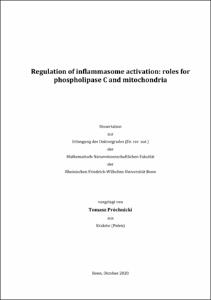Próchnicki, Tomasz: Regulation of inflammasome activation: roles for phospholipase C and mitochondria. - Bonn, 2021. - Dissertation, Rheinische Friedrich-Wilhelms-Universität Bonn.
Online-Ausgabe in bonndoc: https://nbn-resolving.org/urn:nbn:de:hbz:5-63399
Online-Ausgabe in bonndoc: https://nbn-resolving.org/urn:nbn:de:hbz:5-63399
@phdthesis{handle:20.500.11811/9261,
urn: https://nbn-resolving.org/urn:nbn:de:hbz:5-63399,
author = {{Tomasz Próchnicki}},
title = {Regulation of inflammasome activation: roles for phospholipase C and mitochondria},
school = {Rheinische Friedrich-Wilhelms-Universität Bonn},
year = 2021,
month = aug,
note = {Inflammasomes are protein complexes serving as activation platforms for the protease caspase-1, which leads to a pro-inflammatory type of cell death termed pyroptosis and to maturation and release of the cytokines interleukin- (IL)-1beta and IL-18. These processes are involved in host protection against pathogens and in the control of commensal microbial communities; however, under pathological conditions, they may contribute to diseases such as Alzheimer’s disease, atherosclerosis, gout, or type 2 diabetes. Several receptors and sensors are capable of assembling inflammasomes. For example, absent in melanoma 2 (AIM2) triggers inflammasome formation in the presence of cytosolic double-stranded (ds) DNA, whereas NACHT, LRR, and PYD domains-containing protein 3 (NLRP3) nucleates the inflammasome in response to multiple stimuli, many of which deplete the cytosolic pool of K+ ions.
The molecular mechanisms governing the NLRP3 inflammasome activation are incompletely understood. Here, I characterized the inflammasome activation by m-3M3FBS, a reported phospholipase C (PLC) agonist previously suggested to activate NLRP3. Unexpectedly, I found that the m-3M3FBS-induced inflammasome assembly does not require NLRP3. Furthermore, I provided evidence that PLC inhibitors, previously reported to inhibit the NLRP3 inflammasome formation, do so through off-target effects. These observations raised the questions of which sensors/receptors are involved in inflammasome formation in cells treated with m-3M3FBS, and how this response is initiated.
Using a combination of forward- and reverse-genetic approaches, I identified two inflammasome-forming proteins activated by m-3M3FBS: AIM2 and NLRP10. By employing fluorescence microscopy techniques and pharmacological manipulation of cell signaling, I discovered that the m-3M3FBS mechanism of action consists of the induction of mitochondrial (mt) rupture. This damage exposes mtDNA to AIM2, leading to inflammasome formation. In opposition to the previously proposed models of inflammasome activation, NLRP3 was not involved in this response to mtDNA. The activation of the NLRP10 inflammasome was also mtDNA-independent, but likely relying on another factor exposed by the disrupted organelles. In further experiments, I identified three more activators of the AIM2 and NLRP10 inflammasomes (thapsigargin, SMBA1, and SC-10) and two NLRP10-specific inflammasome activators (o-3M3FBS and SC-9).
In my Thesis, I characterize in detail the off-target activity of m-3M3FBS as an inducer of mitochondrial damage. I also provide evidence that AIM2 can be activated by endogenous mtDNA. Furthermore, I describe NLRP10 as a novel inflammasome-forming sensor possibly responding to mitochondrial rupture. Finally, my findings indicate that the NLRP3 inflammasome formation is not dependent on PLC and mtDNA, significantly simplifying the current model of NLRP3 activation.},
url = {https://hdl.handle.net/20.500.11811/9261}
}
urn: https://nbn-resolving.org/urn:nbn:de:hbz:5-63399,
author = {{Tomasz Próchnicki}},
title = {Regulation of inflammasome activation: roles for phospholipase C and mitochondria},
school = {Rheinische Friedrich-Wilhelms-Universität Bonn},
year = 2021,
month = aug,
note = {Inflammasomes are protein complexes serving as activation platforms for the protease caspase-1, which leads to a pro-inflammatory type of cell death termed pyroptosis and to maturation and release of the cytokines interleukin- (IL)-1beta and IL-18. These processes are involved in host protection against pathogens and in the control of commensal microbial communities; however, under pathological conditions, they may contribute to diseases such as Alzheimer’s disease, atherosclerosis, gout, or type 2 diabetes. Several receptors and sensors are capable of assembling inflammasomes. For example, absent in melanoma 2 (AIM2) triggers inflammasome formation in the presence of cytosolic double-stranded (ds) DNA, whereas NACHT, LRR, and PYD domains-containing protein 3 (NLRP3) nucleates the inflammasome in response to multiple stimuli, many of which deplete the cytosolic pool of K+ ions.
The molecular mechanisms governing the NLRP3 inflammasome activation are incompletely understood. Here, I characterized the inflammasome activation by m-3M3FBS, a reported phospholipase C (PLC) agonist previously suggested to activate NLRP3. Unexpectedly, I found that the m-3M3FBS-induced inflammasome assembly does not require NLRP3. Furthermore, I provided evidence that PLC inhibitors, previously reported to inhibit the NLRP3 inflammasome formation, do so through off-target effects. These observations raised the questions of which sensors/receptors are involved in inflammasome formation in cells treated with m-3M3FBS, and how this response is initiated.
Using a combination of forward- and reverse-genetic approaches, I identified two inflammasome-forming proteins activated by m-3M3FBS: AIM2 and NLRP10. By employing fluorescence microscopy techniques and pharmacological manipulation of cell signaling, I discovered that the m-3M3FBS mechanism of action consists of the induction of mitochondrial (mt) rupture. This damage exposes mtDNA to AIM2, leading to inflammasome formation. In opposition to the previously proposed models of inflammasome activation, NLRP3 was not involved in this response to mtDNA. The activation of the NLRP10 inflammasome was also mtDNA-independent, but likely relying on another factor exposed by the disrupted organelles. In further experiments, I identified three more activators of the AIM2 and NLRP10 inflammasomes (thapsigargin, SMBA1, and SC-10) and two NLRP10-specific inflammasome activators (o-3M3FBS and SC-9).
In my Thesis, I characterize in detail the off-target activity of m-3M3FBS as an inducer of mitochondrial damage. I also provide evidence that AIM2 can be activated by endogenous mtDNA. Furthermore, I describe NLRP10 as a novel inflammasome-forming sensor possibly responding to mitochondrial rupture. Finally, my findings indicate that the NLRP3 inflammasome formation is not dependent on PLC and mtDNA, significantly simplifying the current model of NLRP3 activation.},
url = {https://hdl.handle.net/20.500.11811/9261}
}






